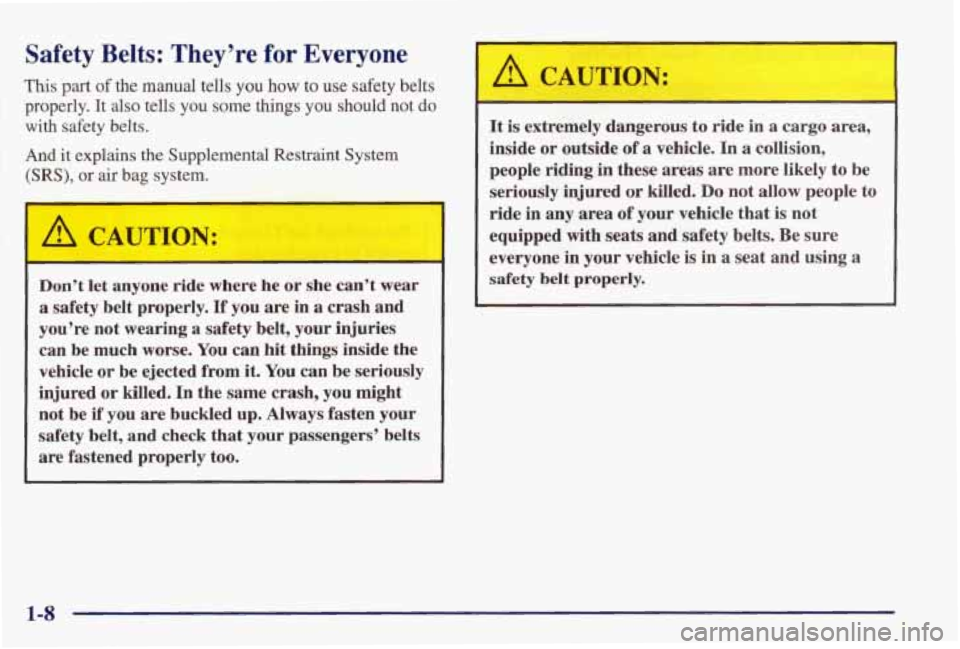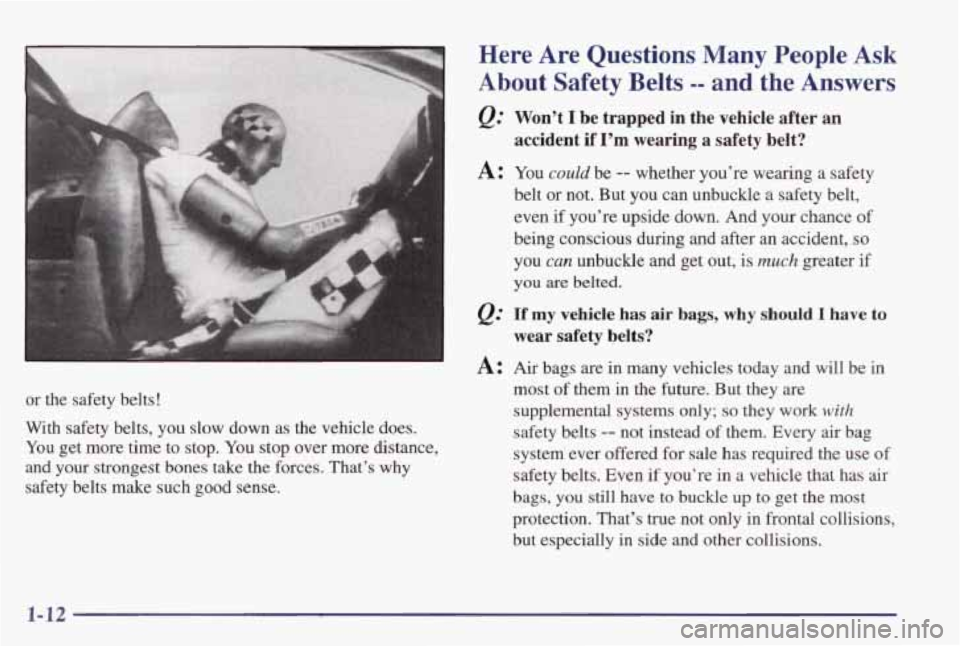Page 2 of 402

The 1998 Pontiac Grand Prix Owner’s Manual
1-1
2-1
3-1
4-1
5- 1
6-1
7- 1
8-1
9-1
Seats and Restraint Systems
This section tells you how to use your seats and safety belts properly. It also explains \
the “SRS” system.
Features and Controls
This section explains how to start and operate your vehicle.
Comfort Controls and Audio Systems
This section tells you how to adjust the ventilation and comfort controls and how to operate \
your audio system.
Your Driving and the Road
Here you’ll find helpful information and tips about the road\
and how to drive under different conditions.
Problems on the Road
This section tells what to do if you have a problem while driving, such as a flat tire or overheated engine, etc.
Service and Appearance Care
Here the manual tells you how to keep your vehicle running properly and looking good.
Maintenance Schedule
This section tells you when to perform vehicle maintenance and what fluids and lubrica\
nts to use.
Customer Assistance Information
This section tells you how to contact Pontiac for assistance and how to get service and owner publications.
It also gives you information on “Reporting Safety Defects” on page
8-10.
Index
Here’s an alphabetical listing of almost every subject in this manual. You can use it to quickly find
something you want to read.
i
Page 6 of 402
Vehicle Symbols
These are some of the symbols you may find on your vehicle.
For example,
these symbols are used on an
original battery:
POSSIBLE A
CAUTION
INJURY
PROTECT EYES BY
SHIELDING
CAUSTIC
I
BURNS I
AVOID
SPARKS
OR
FLAMES
SPARK
OR ,\I/,
COULD
FLAME
EXPLODE BAllERY
These symbols are important for you and
your passengers
whenever your
vehicle is
driven:
n
UNLOCK Fol
FASTEN
SEAT
BELTS
op
AIR BAG p
These symbols
have to do with
your lamps:
SIGNALS 6
TURN
PARKING
p$ LAMPS
FOG LAMPS
$0
These symbols are
on some of
your controls:
WINDSHIELD
WIPER
WINDSHIELD DEFROSTER
VENTILATING
1
These symbols are used on
warning and
indicator lights:
COOLANT
TEMP
-
CHARGING I-1
BAllERY
SYSTEM
BRAKE
(0)
h
ENGINE OIL
PRESSURE
Here are some
other symbols
you may see:
FUSE
LIGHTER
m
HORN tcr
SPEAKER
b
FUEL e3
V
Page 8 of 402
v Section 1 Seats and Restraint Systems
Here you’ll find information about the seats in your Pontiac and how to use your safety belts properly. You can also
learn about some things you should not do with air bags and safety belts.
1-2
1-8
1-12
1-13
1-14
1-21
1-22
1-22
1-30
Seats and Controls
Safety Belts: They’re for Everyone
Here
Are Questions Many People Ask
About Safety Belts--and the Answers
How to Wear Safety Belts Properly
Driver Position
Safety Belt Use During Pregnancy
Right Front Passenger Position
Supplemental Restraint System (SRS)
Rear Seat Passengers
1-35
1-38
1-52
1-65
1-67
1-68
1-68
1-33 Rear Safety Belt Comfort Guides for
Children and Small Adults
Children
Built-in Child Restraint (Option)
Child Restraints
Larger Children Safety Belt Extender
Checking Your
Restraint Systems
Replacing Restraint System
Parts
After a Crash
Page 13 of 402
But don’t have a seatback reclined if your vehicle is moving.
Sitting in a reclined position when your vehicle is
in motion can be dangerous. Even if you buckle
up, your
safety belts can’t do their job when
you’re reclined like this.
The shoulder belt can’t do its job because it
won’t be against your body. Instead, it will be in
front of you. In
a crash you could go into it,
receiving neck or other injuries.
The lap belt can’t do its job either. In a crash the
belt could go up over your abdomen. The belt
forces would
be there, not at your pelvic bones.
This could cause serious internal injuries.
For proper protection when the vehicle
is in
motion, have the seatback upright. Then sit well
back
in the seat and wear your safety belt properly.
Head Restraints
Slide the head restraint up or down so that the top of the
restraint is closest to the top
of your ears. This position
reduces the chance
of a neck injury in a crash.
1-6
Page 15 of 402

Safety Belts: They’re for Everyone
This part of the manual tells you how to use safety belts
properly. It also tells you
some things you should not do
with safety belts.
And it explains the Supplemental Restraint System
(SRS), or air bag system.
Don’t let anyone ride where he or she can’t wear
a safety belt properly. If you are in a crash and
you’re not wearing a safety belt, your injuries
can be much worse. You can hit things inside the
vehicle or be ejected from it. You can
be seriously
injured
or killed. In the same crash, you might
not be if
you are buckled up. Always fasten your
safety belt,
and check that your passengers’ belts
are fastened properly too.
A CAUTION:
It is extremely dangerous to ride in a cargo area,
inside or outside of a vehicle. In
a collision,
people riding in these areas are more likely to be
seriously injured or
killed. Do not allow people to
ride in any
area of your vehicle that is not
equipped with seats and safety belts. Be sure
everyone
in your vehicle is in a seat and using a
safety belt properly.
1-8
Page 16 of 402
Your vehicle has a light
that comes
on as a reminder
to buckle up. (See “Safety
Belt Reminder Light” in
the Index.)
In most states and Canadian provinces, the law says to
wear safety belts. Here’s why:
They work.
You never know if you’ll be in a crash. If you do have a
crash, you don’t know
if it will be a bad one.
A few crashes are mild, and some crashes can be so
serious that even buckled up a person wouldn’t survive.
But most crashes are in between.
In many of them,
people who buckle up can survive and sometimes walk
away. Without belts they could have been badly hurt or killed.
After more than
30 years of safety belts in vehicles,
the facts are clear. In most crashes buckling up does
matter
... a lot!
Why Safety Belts Work
When you ride in or on anything, you go as fast as
it goes.
. ‘a
A
1
Take the simplest vehicle. Suppose it’s just a seat
on wheels.
1-9
Page 19 of 402

”-
or the safety belts!
With safety belts, you slow down as the vehicle does.
You get more time to stop. You stop over more distance,
and your strongest bones take the forces. That’s why
safety belts make such good sense.
Here Are Questions Many People Ask
About Safety Belts -- and the Answers
@ Won’t I be trapped in the vehicle after an
accident if I’m wearing a safety belt?
A: You could be -- whether you’re wearing a safety
belt or not. But
you can unbuckle a safety belt,
even
if you’re upside down. And your chance of
being conscious during and after an accident,
so
you can unbuckle and get out, is much greater if
you are belted.
If my vehicle has air bags, why should I have to
wear safety belts?
A: Air bags are in many vehicles today and will be in
most
of them in the future. But they are
supplemental systems only;
so they work with
safety belts -- not instead of them. Every air bag
system ever offered for sale has required the use of
safety belts. Even if you’re in a vehicle that has
air
bags, you still have to buckle up to get the most
protection. That’s true not only in frontal collisions,
but especially in side and other collisions.
1-12
Page 20 of 402
&: If I’m a good driver, and I never drive far from
A: You may be an excellent driver, but if you’re in an
home, why should I wear safety belts?
accident -- even one that isn’t your fault -- you and
your passengers can be hurt. Being a good driver
doesn’t protect you from things beyond your
control, such
as bad drivers.
Most accidents occur within
25 miles (40 km) of
home. And the greatest number of serious injuries
and deaths occur at speeds
of less than 40 mph
(65 kmlh).
Safety belts are for everyone.
How to Wear Safety Belts Properly
Adults
This part is only for people of adult size.
Be aware that there are special things to know about safety
belts and children. And there are different rules for smaller
children and babies.
If a child will be riding in your
vehicle,
see the part of this manual called “Children.”
Follow those rules for everyone’s protection.
First, you’ll want to know which restraint systems your vehicle has.
We’ll start with the driver position.
1-13